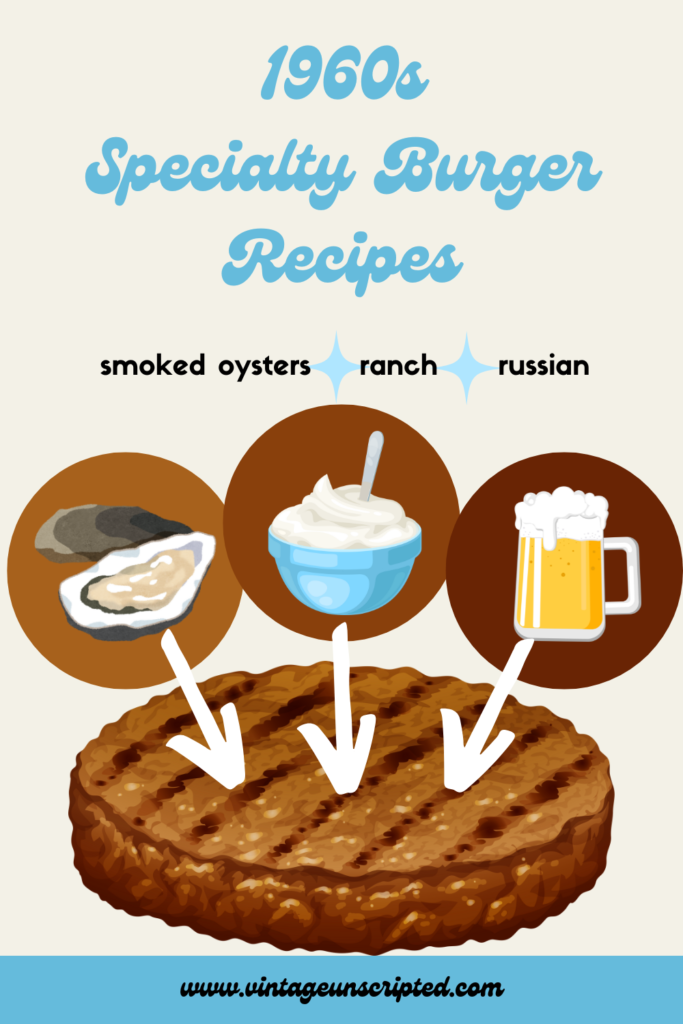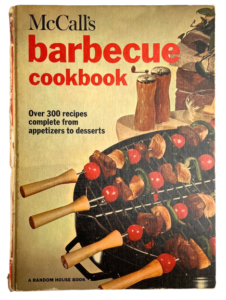 Burgers are giving ice cream a run for its money when it comes to variations. Burger discourse has the same gravitas as Broadway play reviews and fantasy football stats. Everyone has an Opinion. Which is what makes these specialty burger recipes from McCall’s Barbecue Cookbook (1966) interesting. The add-ins are unexpected, that’s for sure. You cannot read these recipes and not have an Opinion.
Burgers are giving ice cream a run for its money when it comes to variations. Burger discourse has the same gravitas as Broadway play reviews and fantasy football stats. Everyone has an Opinion. Which is what makes these specialty burger recipes from McCall’s Barbecue Cookbook (1966) interesting. The add-ins are unexpected, that’s for sure. You cannot read these recipes and not have an Opinion.
Before we get to the burgers, we need to discuss one of the ingredients, monosodium glutamate (MSG). All three recipes call for it. This raised one eyebrow because it has bad reputation for giving people headaches and more. That this bad reputation is undeserved raised both eyebrows.
It’s a long story; here’s the Reader’s Digest Condensed version. Japanese chemist Kikunae Ikeda discovered MSG while researching the flavor of a seaweed broth his wife made. In 1909, he isolated the glutamic acid that produced the flavor, added water and table salt to stabilize it, patented his blend and marketed the crystalized white powder as a flavor enhancer. He adapted “umami,” his name for the savory, meaty taste, from the Japanese word for “tasty.”
MSG’s popularity took Japan and gradually the world by storm. In the US, it was used to make cheap foods, such as dehydrated soups, taste better. The US Army started adding MSG to food rations after discovering that soldiers in the South Pacific preferred the Japanese-issued meals made with it over American rations made without it.
In the 1950s, when Americans were discovering and loving Chinese food made with MSG, it became a common kitchen seasoning like seasoned salt. It was used in all kinds of packaged and prepared foods. But that came to a screeching halt in 1968. The New England Journal of Medicine published a doctor’s letter describing how he had neck and arm pain, heart palpitations, headache and nausea regularly after eating Chinese food. He theorized that the MSG, cooking wine and high sodium levels could cause it. Letters citing the same symptoms and other maladies flooded in. And thus “Chinese Food Syndrome” was born.
The 1960s public was primed to be suspicious of chemicals. Rachel Carson’s Silent Spring (1962) exposed the hazards of miracle pesticide DDT. Chemical food additives, especially sweeteners like cyclamates (banned in 1970) and some dyes, were also viewed with a hairy eyeball. Add in some xenophobia against the Chinese, also prevalent in the 1960s, and hoo boy, MSG went from miracle taste enhancer to additive non grata. “No MSG” was added to advertisements and menus at Chinese restaurants.
Despite extensive research in the 70s and 80s that showed MSG to be innocent of causing all the health symptoms it was alleged to cause, it’s still looked at with suspicion. However, some people might might be sensitive to it the way some people are sensitive to gluten, and they might have symptoms. It’s currently sold the way spices are, and can be found in lots of packaged foods. Award-winning chefs and food influencers are preaching its virtues, but the bad reputation lives on, like most rumors do.
Deciding whether or not to use it in these recipes is purely up to you. Omitting it is not like omitting baking powder from banana bread. The burgers will still taste fine.
Now let’s get to the specialty burger recipes. All three of these burgers are served bunless. We aren’t used to seeing naked burgers today, but in the 60s and 70s, they were often served that way, sitting boldly on the plate next to the mashed potatoes.
First up, adding a maritime touch to a burger:
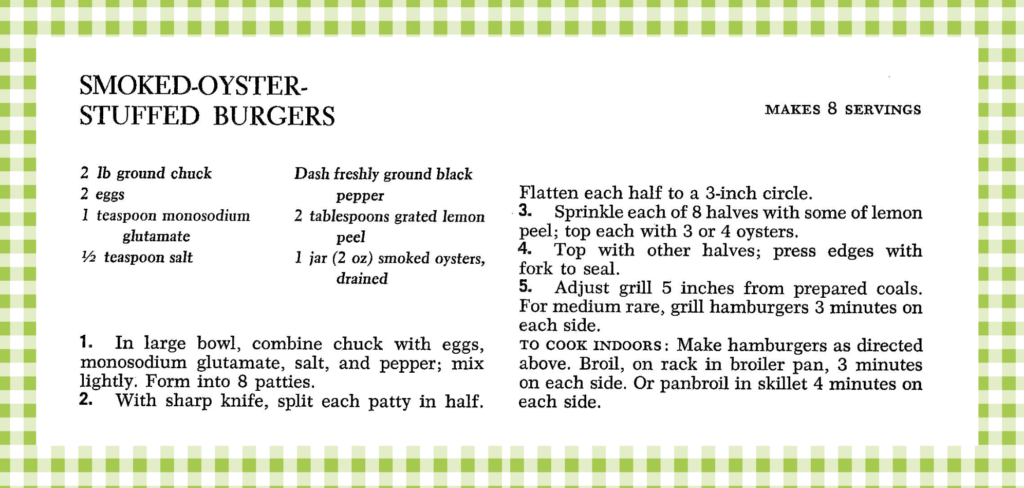
Smoked oysters on crackers were a cocktail nibble in the 1950s and 60s, and a lux cocktail nibble at that. The first ad for canned smoked oysters dates from 1936. The oyster’s downfall is alleged to be caused by a scene in the Australian movie Stork (1971), where the title character pulls a smoked oyster out of his nose at a cocktail party. Although I would probably hold my own in a “Vintage Movies” category on Jeopardy!, somehow this particular film has escaped my notice. And now, though I have not seen the movie, I can not erase the imagined image from my memory. Sorry.
Next, something rib-sticking and saucy from the ranch:
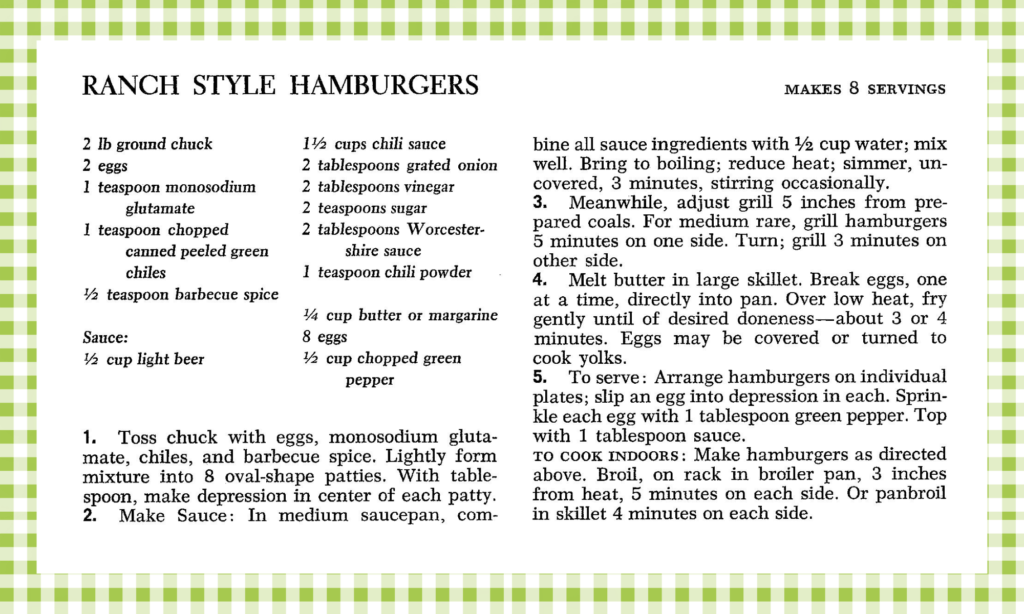
Eggs and beer-based sauce on a burger. Interesting. A couple of notes on ingredients. There are commercial “barbecue spice” mixes, but a barbecue rub would probably also do. And “light beer” is not lower calorie beer since this cookbook is from 1966 and the first commercially available “diet” beer was introduced in 1967 by Rhinegold. Marketed as Gablinger’s, it was not a blockbuster beer…until Miller Brewing revived it as Miller Lite in 1975. “Light beer” in this case is a pilsner or lager and not a stout.
Lastly, a burger with Russian flair:
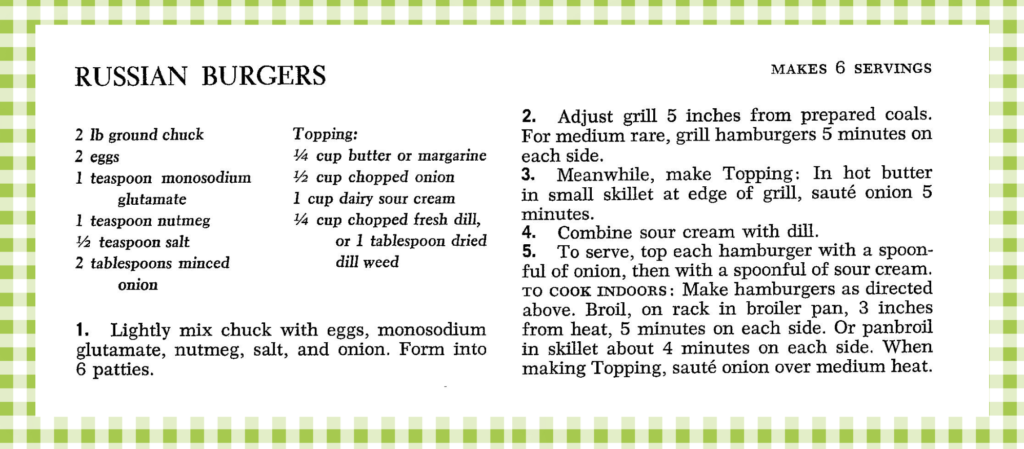
Sour cream is wicked popular in Russian cuisine, so why not top a burger with it. With the eggs in the meat, these burgers probably have a meatloafy quality.
Which of these specialty burger recipes strikes your fancy? Let us know in the comments.
If you’re unfamiliar with McCall’s, the publisher of this cookbook, it was a powerhouse publishing company of mostly women-oriented general interest magazines and books from the turn of the century until the early 2000s. The flagship publication was McCall’s magazine, a must-read women’s publication from 1897 until 2001 when it became Rosie magazine. It ceased publication in 2002. It deserves a Vintage Unscripted post of its own.
Read more about the history of MSG here (and no, I’m not in the pocket of Big MSG, just doing a little myth busting):
A Short History of MSG: Good Science, Bad Science, and Taste Cultures, from the USC USA-China Institute is a deep dive.
How MSG Got a Bad Rap: Flawed Science and Xenophobia, from Five Thirty Eight.
MSG is the most misunderstood ingredient of the century. That’s finally changing, from CNN
In Praise of MSG, the Unfairly Maligned Kitchen MVP, foodandwine.com
Curious about the history of smoked oysters?
1971 Smoked Oysters Fall from Grace, Australian Food Timeline
